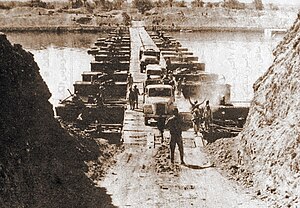1973 October War
| Yom Kippur War/October War | |||||||||
|---|---|---|---|---|---|---|---|---|---|
| Part of the Cold War and Arab–Israeli conflict | |||||||||
 Egyptian forces crossing the Suez Canal on October 7 |
|||||||||
|
|||||||||
| Belligerents | |||||||||
|
Supported by: |
|||||||||
| Commanders and leaders | |||||||||
| Strength | |||||||||
|
Egypt:
3,000 troops
Total:
|
||||||||
| Casualties and losses | |||||||||
|
Egypt: 5,000–15,000 dead
Syria:
Total casualties:
|
||||||||
Israeli military victory
Supported by:
The Yom Kippur War, Ramadan War, or October War Hebrew: מלחמת יום הכיפורים Milẖemet Yom HaKipurim or מלחמת יום כיפור Milẖemet Yom Kipur); (Arabic: حرب أكتوبر Ḥarb ʾUktōbar, or حرب تشرين Ḥarb Tišrīn, also known as the 1973 Arab–Israeli War, was a war fought by a coalition of Arab states led by Egypt and Syria against Israel from October 6 to 25, 1973. The fighting mostly took place in the Sinai and the Golan Heights, territories that had been occupied by Israel since the Six-Day War of 1967. Egyptian President Anwar Sadat wanted also to reopen the Suez Canal. Neither specifically planned to destroy Israel, although the Israeli leaders could not be sure of that.
The war began when the Arab coalition launched a joint surprise attack on Israeli positions in the Israeli-occupied territories on Yom Kippur, the holiest day in Judaism, which also occurred that year during the Muslim holy month of Ramadan. Egyptian and Syrian forces crossed ceasefire lines to enter the Sinai Peninsula and the Golan Heights respectively. Both the United States and the Soviet Union initiated massive resupply efforts to their respective allies during the war, and this led to a near-confrontation between the two nuclear superpowers.
...
Wikipedia
